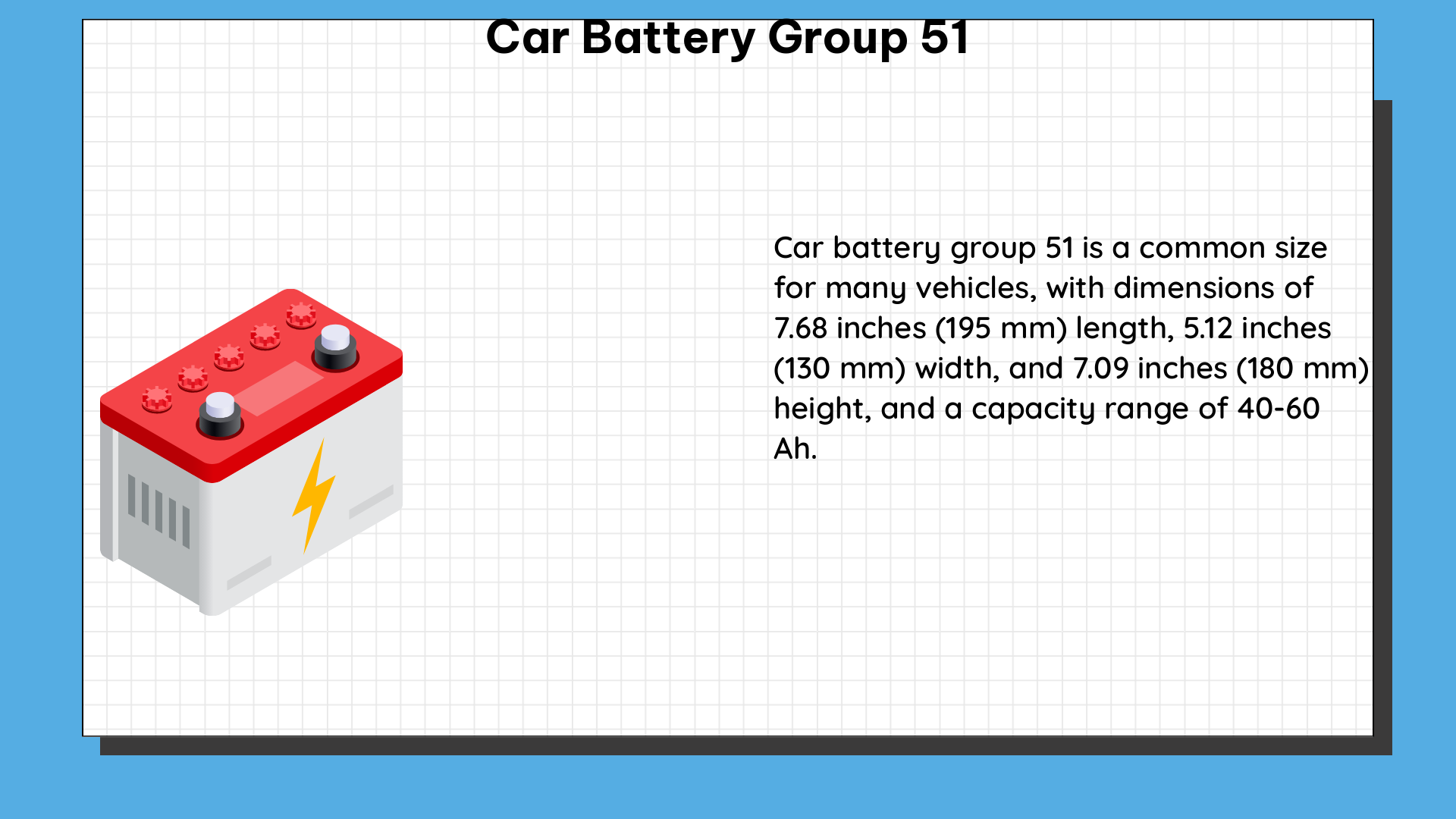Car battery Group 51 is a standardized battery size that is widely used in various vehicles, including passenger cars, trucks, lawn mowers, ATVs, motorcycles, snowmobiles, jet skis, farm equipment, and industrial equipment. This battery group is classified according to its voltage, maximum overall dimensions, terminal arrangement, and special features that affect its fitment in a vehicle.
Understanding the Characteristics of Car Battery Group 51
The four key characteristics that define a battery as a specific group size are:
- Size: The physical dimensions of the battery must be within 2mm of the group size specifications to ensure proper fitment in the vehicle.
- Performance: The battery’s performance is measured in terms of cold cranking amps (CCA) or amp-hours (Ah), depending on the age of the vehicle.
- Terminal Arrangement: The position of the battery terminals must align with the vehicle’s electrical cables to ensure proper connection.
- Chemistry: Batteries are classified into group sizes based on their chemistry, which can include lead-acid with flooded technology, enhanced flooded battery (EFB), absorbed glass mat (AGM), or lithium-ion.
Technical Specifications of Car Battery Group 51

Here are the detailed technical specifications of car battery Group 51:
| Specification | Value |
|---|---|
| Voltage | 12 volts |
| Physical Size | Within 2mm of the group size dimensions |
| Terminal Arrangement | Varies by specific battery model |
| Chemistry | Lead-acid with flooded technology, EFB, AGM, or lithium-ion |
| Cold Cranking Amps (CCA) | Varies by specific battery model, but the 51 battery typically has higher CCA than the 51R battery |
| Dimensions (L x W x H) | Approximately 9.4 x 6.9 x 7.7 inches (240 x 175 x 190 mm) |
| Weight | Typically between 35-45 lbs (16-20 kg) |
Unique Perspective on Car Battery Group 51
While it is essential to ensure that the correct battery group is used for a vehicle to maintain proper fit and performance, it is also important to consider the value that a battery provides. For example, the 51 battery may offer a better value with higher CCA compared to the similarly priced 51R battery. Therefore, when purchasing a replacement battery, it is recommended to evaluate both the group size and the overall value the battery provides.
DIY Guide for Replacing Car Battery Group 51
When replacing a car battery Group 51, it is crucial to follow the proper steps to ensure a safe and successful installation. Here’s a step-by-step guide:
- Disconnect the Negative Cable: Before removing the old battery, disconnect the negative (-) cable first to prevent any electrical shorts.
- Remove the Old Battery: Once the negative cable is disconnected, you can safely remove the old battery from the vehicle.
- Clean the Battery Tray: Thoroughly clean the battery tray to remove any corrosion or debris, ensuring a clean surface for the new battery.
- Install the New Battery: Carefully place the new Group 51 battery in the tray, making sure it is securely mounted and the terminals are properly aligned.
- Connect the Positive Cable: Attach the positive (+) cable to the new battery’s positive terminal.
- Connect the Negative Cable: Finally, connect the negative (-) cable to the battery’s negative terminal, ensuring a secure connection.
Remember to dispose of the old battery properly and recycle it if possible. It is also essential to ensure that the new battery is properly secured and the terminals are aligned to prevent any electrical issues.
References
- BCI Group Sizes | Battery Council International. (n.d.). Retrieved May 24, 2024, from https://batterycouncil.org/battery-facts-benefits/industry-stats/vehicle-battery-replacement-data/bci-group-sizes/
- Question for Costco employees re: car batteries – Reddit. (2023, February 17). Retrieved May 24, 2024, from https://www.reddit.com/r/Costco/comments/114ojxz/question_for_costco_employees_re_car_batteries/
- Battery Replacement: Does it matter if I use 51R instead of 51 group … – Drive Accord. (2020, April 01). Retrieved May 24, 2024, from https://www.driveaccord.net/threads/battery-replacement-does-it-matter-if-i-use-51r-instead-of-51-group-why-yes-yes-it-does-matter.551441/

The lambdageeks.com Core SME Team is a group of experienced subject matter experts from diverse scientific and technical fields including Physics, Chemistry, Technology,Electronics & Electrical Engineering, Automotive, Mechanical Engineering. Our team collaborates to create high-quality, well-researched articles on a wide range of science and technology topics for the lambdageeks.com website.
All Our Senior SME are having more than 7 Years of experience in the respective fields . They are either Working Industry Professionals or assocaited With different Universities. Refer Our Authors Page to get to know About our Core SMEs.